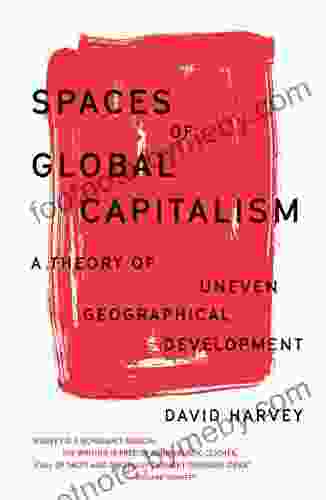Unveiling the Enigma of Regional Disparities: A Journey through the Theory of Uneven Geographical Development

The world we inhabit is a tapestry of contrasting landscapes, from bustling metropolises to remote villages. Amidst this diversity, a persistent enigma emerges: the unequal distribution of development across regions. Why do some areas thrive while others languish? To unravel this puzzle, we turn to the Theory of Uneven Geographical Development, a profound concept that sheds light on the underlying forces shaping regional disparities.
At its core, the Theory of Uneven Geographical Development posits that economic growth and development are not uniform processes. Rather, they tend to concentrate in specific regions, creating a stark contrast between "core" and "periphery" areas. This unevenness is not merely a coincidence but rather the result of a complex interplay of historical, economic, and social factors.
Historically, certain regions emerged as centers of trade, industry, or political power. These hubs attracted capital, skilled labor, and infrastructure, fostering a virtuous cycle of growth. Conversely, other regions were relegated to the periphery, lacking the necessary resources and connections to participate in this economic expansion.
4.7 out of 5
| Language | : | English |
| File size | : | 1115 KB |
| Text-to-Speech | : | Enabled |
| Enhanced typesetting | : | Enabled |
| X-Ray | : | Enabled |
| Word Wise | : | Enabled |
| Print length | : | 161 pages |
| Screen Reader | : | Supported |
To illustrate this concept, geographers have developed the core-periphery model. In this model, the core regions are highly developed, with strong economies and sophisticated infrastructure. They exert a gravitational pull on the periphery, drawing resources, labor, and capital towards them.
The periphery regions, on the other hand, are characterized by lower levels of development, limited economic opportunities, and poor living conditions. They often supply raw materials and cheap labor to the core regions, reinforcing the cycle of inequality.
Numerous factors contribute to the emergence of uneven geographical development. These include:
- Initial Advantages: Certain regions possess inherent advantages, such as natural resources, strategic location, or access to markets. These advantages create a foundation for economic growth.
- Path Dependence and Lock-In: Economies often follow a path of incremental improvement, making it difficult for new industries or regions to enter the market. This path dependence can lead to persistent disparities.
- Market Forces: Free market economies tend to concentrate economic activity in areas with existing advantages. This can further exacerbate regional inequalities.
- Government Policies: Government policies, such as tax incentives or infrastructure investments, can influence the distribution of economic activity.
- Social and Cultural Factors: Cultural norms, education levels, and social networks can also contribute to regional disparities.
The consequences of uneven geographical development are far-reaching, affecting both individuals and societies:
- Economic Disparities: Uneven development leads to significant income and wealth gaps between core and periphery regions.
- Social Inequality: Regional disparities often translate into social inequalities, with limited access to education, healthcare, and employment opportunities in periphery areas.
- Environmental Degradation: Economic activities concentrated in core regions can strain natural resources and lead to environmental degradation.
- Political Instability: Regional disparities can fuel political tensions, resentment, and demands for greater autonomy.
Recognizing the profound implications of uneven development, policymakers have sought strategies to address this challenge:
- Regional Policies: Governments can implement regional policies to support economic growth in disadvantaged areas. This may involve infrastructure investments, tax incentives, and workforce training programs.
- Trade and Investment: Promoting trade and investment between core and periphery regions can help spread economic benefits.
- Education and Human Capital: Investing in education and developing human capital in periphery regions can enhance their economic potential.
- Sustainable Development: Adopting sustainable development practices can help mitigate the negative environmental impacts of economic growth and reduce regional disparities.
- Global Cooperation: International organizations and development agencies can provide assistance and support for addressing uneven development in developing countries.
The Theory of Uneven Geographical Development has been applied to numerous case studies around the world. Two notable examples include:
- India: India's economic growth has been concentrated in a few major metropolitan areas, leaving vast rural areas lagging behind. Government policies aimed at promoting inclusive growth have sought to address this disparity.
- China: China's rapid economic expansion has created a stark divide between coastal developed regions and less developed inland provinces. The Chinese government has implemented policies to bridge this gap, such as the "Western Development Strategy."
The Theory of Uneven Geographical Development provides a profound understanding of the complex forces that shape regional disparities. By identifying the causes and consequences of this phenomenon, we can better develop strategies to promote more equitable and sustainable economic growth. Policymakers, researchers, and development practitioners must continue to explore innovative solutions to address the ongoing challenge of uneven geographical development, ensuring that the benefits of economic progress reach all corners of our global society.
4.7 out of 5
| Language | : | English |
| File size | : | 1115 KB |
| Text-to-Speech | : | Enabled |
| Enhanced typesetting | : | Enabled |
| X-Ray | : | Enabled |
| Word Wise | : | Enabled |
| Print length | : | 161 pages |
| Screen Reader | : | Supported |
Do you want to contribute by writing guest posts on this blog?
Please contact us and send us a resume of previous articles that you have written.
 Book
Book Novel
Novel Page
Page Chapter
Chapter Text
Text Story
Story Genre
Genre Reader
Reader Library
Library Paperback
Paperback E-book
E-book Magazine
Magazine Newspaper
Newspaper Paragraph
Paragraph Sentence
Sentence Bookmark
Bookmark Shelf
Shelf Glossary
Glossary Bibliography
Bibliography Foreword
Foreword Preface
Preface Synopsis
Synopsis Annotation
Annotation Footnote
Footnote Manuscript
Manuscript Scroll
Scroll Codex
Codex Tome
Tome Bestseller
Bestseller Classics
Classics Library card
Library card Narrative
Narrative Biography
Biography Autobiography
Autobiography Memoir
Memoir Reference
Reference Encyclopedia
Encyclopedia Elizabeth Wissner Gross
Elizabeth Wissner Gross David Schoem
David Schoem Rachel Ormston
Rachel Ormston Douglas Deur
Douglas Deur Seth Burkett
Seth Burkett Dawn Loring
Dawn Loring James A Jc Creighton
James A Jc Creighton David Lindahl
David Lindahl David Nash
David Nash David M Adamson
David M Adamson Dawn Brookes
Dawn Brookes David Attenborough
David Attenborough Constance Burris
Constance Burris Colin Woodard
Colin Woodard T J Demos
T J Demos David A Lax
David A Lax Geraldine Woods
Geraldine Woods Daniel Lipkowitz
Daniel Lipkowitz J M Hofer
J M Hofer David S Landes
David S Landes
Light bulbAdvertise smarter! Our strategic ad space ensures maximum exposure. Reserve your spot today!

 Arthur MasonHere's The Info You Need: The Ultimate Guide to Finding the Answers to Your...
Arthur MasonHere's The Info You Need: The Ultimate Guide to Finding the Answers to Your... George BellFollow ·11.6k
George BellFollow ·11.6k Andres CarterFollow ·12.7k
Andres CarterFollow ·12.7k Bill GrantFollow ·17.1k
Bill GrantFollow ·17.1k Brett SimmonsFollow ·14.5k
Brett SimmonsFollow ·14.5k Isaias BlairFollow ·4k
Isaias BlairFollow ·4k Jedidiah HayesFollow ·11.1k
Jedidiah HayesFollow ·11.1k Eli BlairFollow ·8.8k
Eli BlairFollow ·8.8k Rod WardFollow ·14.9k
Rod WardFollow ·14.9k

 Jayden Cox
Jayden CoxFaith Lies and the War on Terror: Exposing the Truth...
In the aftermath of the 9/11...

 Jack Powell
Jack PowellMad About the Trump Era: Mad Magazine 2024
The Trump...

 Warren Bell
Warren BellYou Got This: Tips for Women Who Want to Rock at Real...
Real estate...

 Ernest Cline
Ernest ClineThe Daring Life and Turbulent Times of the Original Girl...
: Embracing the Spirit of Adventure In...
4.7 out of 5
| Language | : | English |
| File size | : | 1115 KB |
| Text-to-Speech | : | Enabled |
| Enhanced typesetting | : | Enabled |
| X-Ray | : | Enabled |
| Word Wise | : | Enabled |
| Print length | : | 161 pages |
| Screen Reader | : | Supported |














